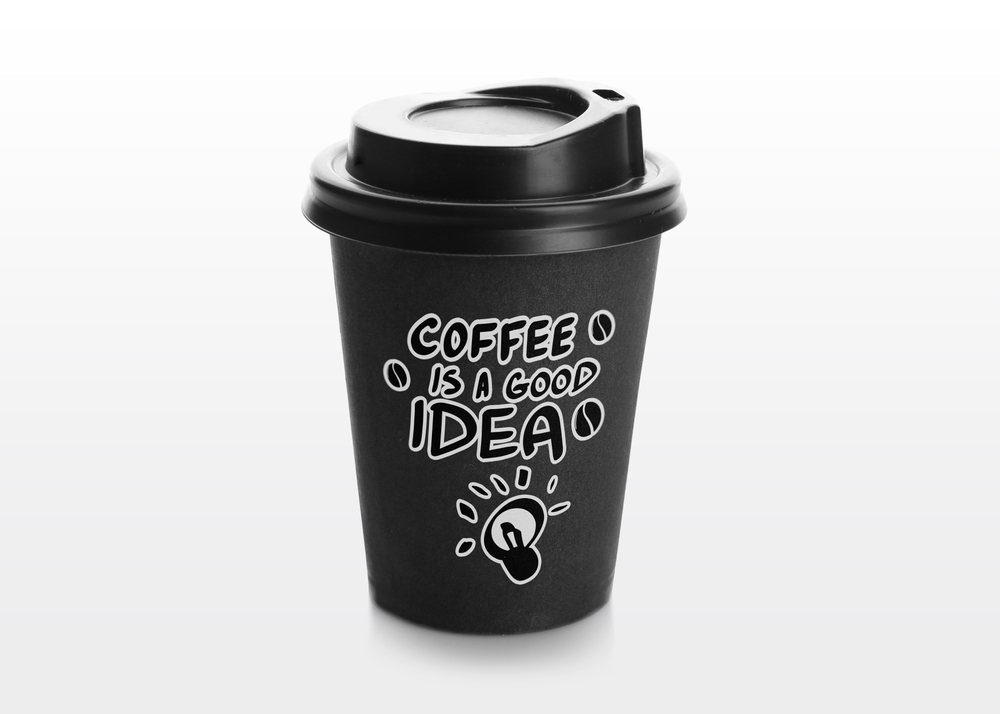Printing Methods for Paper Cups: Elevate Your Brand Experience
By Anttoni Taimela · 20. June 2024
Choosing the right printing method for paper cups isn’t just a production decision; it’s a branding strategy.
This article breaks down the top printing methods for paper cups—offset, digital, and flexography—to help you choose a method that best fits your brand’s quality expectations, order size, and budget. 🥤✨
Exploring the Spectrum of Paper Cup Printing Techniques
 hand holding take away paper cup for coffee
hand holding take away paper cup for coffee
Paper cup printing is more than just a technical process; it’s a powerful tool for advertising and brand building.
By transferring images, designs, and messages onto the surface of paper cups, brands can create a dynamic and engaging customer experience.
Various printing methods offer different advantages, making it essential to choose the right one based on your branding needs and design complexity.
Offset printing, digital printing, and flexographic printing are among the most popular methods for paper cup printing.
Each technique has its strengths, from the high-definition colours of offset printing to the customization flexibility of digital printing, and the efficiency of flexography.
Understanding these methods will help you select the best option to bring your brand to life on paper cups.
Offset Printing: The Classic Approach
Offset printing, using high-quality offset printing ink, is renowned for its ability to produce:
- Full, bright, and high-definition colours
- Ideal for intricate designs and high-volume orders
- Involves transferring the inked image from a metal plate to a rubber blanket, and then onto the paper cup’s surface using an offset printing machine
- Sharp imagery and precise colour reproduction
For businesses looking to print large quantities of paper cups, offset printing is a cost-effective solution. It offers superior quality and consistent colour accuracy, making it perfect for maintaining brand identity across large print runs.
Whether you’re launching a new product or reinforcing your brand, offset printing provides the reliability and quality needed to make a lasting impression.
Digital Printing: Modern Precision
Digital printing has revolutionized the world of paper cup printing with its versatility and precision.
This method is particularly well-suited for short print runs and custom designs, allowing for a range of design elements in smaller quantities.
Unlike traditional methods, digital printing doesn’t require plates, making it a cost-effective solution for limited-budget campaigns.
One of the standout features of digital printing is its exceptional colour reproduction.
It can handle intricate designs and small text with ease, producing vibrant and detailed custom paper cups that capture the essence of your brand.
This flexibility makes digital printing an excellent choice for brands looking to create unique, high-quality designs without committing to large print runs.
Flexography: Efficiency Meets Versatility
Flexographic printing, often referred to as flexo printing, is known for its efficiency and versatility, making it the mainstream choice for high-volume paper cup production.
This method uses a flexible printing plate and environmentally friendly water-based inks, making it a cost-effective and eco-conscious option for businesses.
Flexographic printing can adapt to various substrates, supporting a range of ink types and providing flexibility in design. Some benefits of flexographic printing include:
- Adaptability to different substrates
- Ability to support a range of ink types
- Flexibility in design
- Suitable for producing large quantities of high-quality printed paper cups
Although the colour options may be more limited compared to offset printing, flexography’s adaptability and environmental benefits make it a strong contender for brands looking to produce large quantities of high-quality printed paper cups.
Mastering Color and Detail in Paper Cup Printing
 takeaway coffee paper cup printed phrase
takeaway coffee paper cup printed phrase
Achieving high-quality print on paper cups is critical for conveying vibrant colours and clear details, which are essential for maintaining a strong brand identity.
Offset printing is particularly distinguished by its ability to deliver such high-quality prints, making it suitable for paper cups that require a premium appearance.
While simpler designs with fewer colours are often recommended for maximum effectiveness, advanced printing technologies like offset printing can accommodate more complex and colourful designs without compromising on quality.
Understanding the nuances of colour systems and the challenges of printing on curved surfaces will help you master the art of paper cup printing.
Navigating CMYK and Pantone Matching Systems
The CMYK colour system, which stands for Cyan, Magenta, Yellow, and Key (black), is critical for process printing in paper cups.
This system allows for a wide range of colour reproduction by blending these four base colours, making it ideal for achieving vibrant and accurate colours in your designs.
Pantone colours, on the other hand, are designated with unique numbers and a suffix for the paper stock type, ensuring precise colour matching and consistency across different print runs.
By using the Pantone system alongside CMYK colours, offset printing can maintain brand colour consistency, ensuring that your paper cups always match your brand’s identity. 🟦🟩🟨⬛
Addressing the Challenges of Surface Shape
Printing on the curved surface of paper cups can present significant challenges. These challenges require special adjustments in the printing process to maintain high-quality results.
Techniques such as adjusting the design layout and using flexible printing plates can help overcome these limitations, ensuring that your screen printing paper cups look as impressive as flat-surface prints.
The Role of Substrates in Printing on Paper Cups
Selecting the right substrates is crucial for achieving high-quality prints on paper cups.
The substrate’s roughness, porosity, and surface energy significantly impact ink transfer and behaviour, ultimately affecting the print quality.
Proper ink-substrate contact is essential for producing sharp and vibrant prints, making substrate selection a critical step in the printing process.
Understanding the environmental impact of substrate choices is equally important.
With growing awareness of sustainability, opting for eco-friendly substrates can enhance your brand’s image and reduce your environmental footprint.
From biodegradable coatings to recycled materials, the choice of substrate can make a significant difference. 🌱
Selecting Suitable Substrates for Each Printing Technique
The type and thickness of the substrate play a crucial role in the overall perception of the printed paper cup.
For instance, a 300 gsm board offers a more substantial and durable option, especially important for maintaining product integrity under heat.
Selecting the right substrate ensures that the printed design looks and feels high-quality, aligning with your brand’s standards.
Different printing techniques require different substrates to achieve the best results.
Flexographic printing, for example, benefits from substrates that facilitate proper ink transfer, while offset printing may require smoother surfaces for high-definition prints.
Understanding these requirements helps in making informed decisions about substrate selection.
Understanding the Environmental Impact of Substrate Choices
As businesses increasingly focus on sustainability, choosing environmentally friendly substrates has become more important than ever.
Biodegradable and compostable coatings, such as PLA, offer significant environmental benefits, including easier recyclability and biodegradability.
These eco-friendly options reduce the environmental impact of your paper cups while maintaining high-quality prints.
Using recycled materials or sustainable alternatives not only lowers your brand’s environmental footprint but also enhances your eco-conscious image.
By integrating such substrates into your green printing process, you can align your brand with current sustainability trends, appealing to environmentally conscious consumers.
Establishing Customer Loyalty Through Unique Designs
 woman holding morning coffee paper cup
woman holding morning coffee paper cup
Investing in high-quality printed paper cups can significantly boost customer loyalty.
Serving drinks in superior-quality cups communicates respect and value to your customers, fostering a positive brand experience.
Vibrant colours and eye-catching graphics can make your brand stand out, facilitating recognition and recall.
When designing custom printed paper cups, it’s essential to balance branding with readability. Here are some tips to keep in mind:
- Avoid excessive branding and busy patterns
- Use clear and legible fonts
- Ensure that the text is large enough to be easily read
- Choose colours that contrast well and make the text stand out
- Keep the design simple and clean
Following these guidelines will ensure that your design is easy to read and effectively communicates your brand message.
High-quality printed cups can increase customer retention, leading to substantial increases in profits over time. 💰
Cost Considerations in Paper Cup Printing
Selecting the right paper cup printing method involves careful consideration of costs and budget.
Each printing method, whether offset, flexographic, digital, or screen printing, has its own setup and production cost structures, influencing the cost-effectiveness of your project.
The scale of your advertising campaign can determine the most cost-effective printing method, with some methods offering economies of scale for larger orders.
For large quantity orders, offset printing often emerges as the preferred choice due to its ability to reduce costs per unit at higher volumes.
By understanding the cost structures of different printing methods, you can make informed decisions that balance quality and budget effectively.
Balancing Quality and Budget: A Comparative Analysis
Offset printing is highly cost-effective for large-scale paper cup production, offering consistent quality and a lower unit price as the quantity ordered increases.
While the up-front costs for creating printing plates are higher, this investment pays off with consistent prints across large print runs.
Flexographic printing requires a lower equipment investment than offset printing, but the cost of printing plates can be high.
Digital printing, though carrying a higher price point, offers flexibility and precision for smaller print runs.
By comparing these methods based on cost, quality, and project requirements, you can choose the best option to meet your specific needs and budget constraints.
When to Invest in High-Quality Printing Methods
Investing in high-quality printing methods can:
- Enhance brand perception
- Improve workforce morale, giving employees a sense of pride in the value they deliver to customers
- Offer significant cost savings in the long term by minimizing marketing expenses
- Reduce the need for cup replacements due to quality issues
Choosing top-tier printing for paper cups can streamline operations by eliminating the frequent need to vet and hire new suppliers due to dissatisfaction with print quality.
Effective collaboration with the printing manufacturer and understanding different colour systems ensure that you select the appropriate high-quality printing methods for your needs.
Summary
In conclusion, selecting the right paper cup printing method is crucial for creating a memorable brand experience.
Offset printing offers high-quality prints for large volumes, digital printing provides versatility for smaller runs, and flexographic printing balances efficiency and environmental benefits.
Understanding the role of substrates and the importance of colour accuracy further enhances the quality of your printed paper cups.
By investing in high-quality printing methods and environmentally friendly substrates, you not only improve the perception of your brand but also contribute to sustainability.
Make informed decisions about printing methods and substrates to ensure that your paper cups stand out, resonate with your brand identity, and foster customer loyalty. 💼🌍
Frequently Asked Questions
How are paper cups printed?
Paper cups are printed using a high-quality lithographic press that can produce thousands of copies of the same item in one production run.
What is the best printing method for high-volume paper cup production?
Offset printing is the best method for high-volume paper cup production due to its cost-effectiveness and ability to maintain high-quality prints.
How do I ensure colour consistency across different print runs?
To ensure colour consistency across different print runs, use the Pantone matching system alongside CMYK colours for colour accuracy and consistency.
What are the environmental benefits of using biodegradable coatings for paper cups?
Using biodegradable coatings for paper cups, such as PLA and EarthCoating®, can improve recyclability and biodegradability, ultimately reducing the environmental impact. This provides a more sustainable option for paper cup production.
How can high-quality printed paper cups enhance customer loyalty?
High-quality printed cups communicate value and respect to customers, fostering a positive brand experience and increasing customer retention. This builds customer loyalty and trust in the brand.

